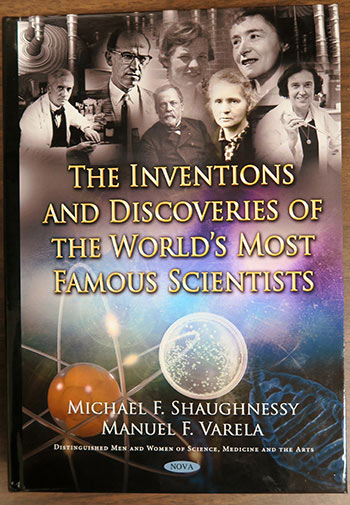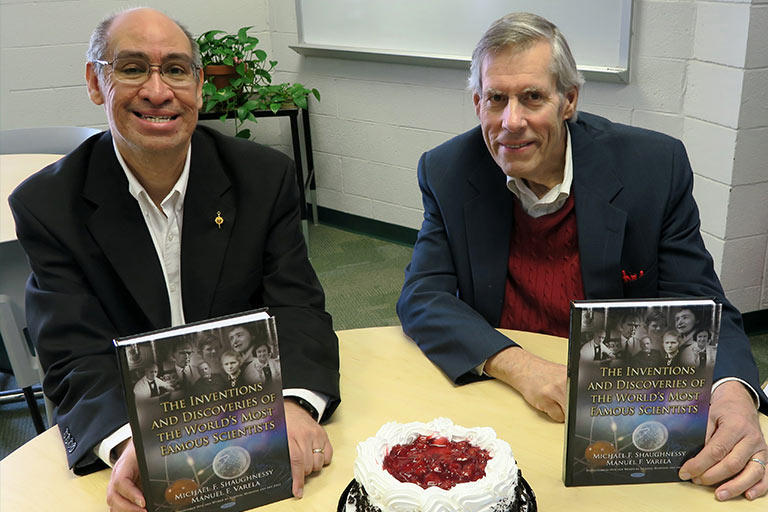Drs. Michael Shaughnessy, professor of education, and Manuel Varela, professor of biology, at Eastern New Mexico University have collaborated on a book published by Nova Science Publishers titled "The Inventions and Discoveries of the World's Most Famous Scientists."
The book follows an interview format with Dr. Shaughnessy asking Dr. Varela questions about the scientists as people and the nature and importance of their work.
A few of the notable names laypersons will recognize in the 38-chapter book are Louis Pasteur, Walter Reed, Marie Curie, Linus Pauling, Francis Crick and James Watson (discoverers of DNA), and Jonas Salk and Albert Sabin (polio vaccine creators).

Dr. Shaughnessy said the book answers such questions as: "Who were these famous men and women of science who gave us so much? What were they like? What motivated them and what led them to their amazing discoveries?"
According to Dr. Varela, the book answers such questions as: "What the most dangerous microbe in the world was: Yersinia pestis, a bacterium that caused the so-called Great Mortality, known also as the Black Death or the plague; why cancer is so common; and why smallpox doesn't exist anymore… or does it?"
Dr. Varela said, "It was a true joy working on the book. Dr. Shaughnessy showed remarkable insight in knowing precisely what questions to ask. His inquiries permitted me to relay a few interesting gems not normally known to the rest of the world. For instance, I once spent a three-hour drive with a Nobel Laureate maneuvering through northern New Mexico's roads on our way to a scientific conference in Taos, New Mexico."
Dr. Varela and a colleague once thought they had "snuck" into a seminar being held by the "great professor Linus Pauling," a two-time Nobelist, only to find out the seminar had been open to the public.
According to Dr. Varela, Peter Mitchell, a 1977 Nobel Prize winner, discovered how to make ATP (Adenosine Triphosphate Molecule) energy without ATP. Many scientists didn't believe him, so he quit his professorship and opened up a dairy farm with his brother. The business became quite lucrative, so he bought an old mansion house and converted it to a laboratory where he conducted experiments that supported the hypothesis. The rest of the scientific community fell into line and converted, too.
Another anecdote shared by the biology professor was about Dr. Eduard Buchner, future father of biochemistry. "Dr. Buchner apparently imbibed a bit too much on the night before his wedding day when he was to marry Ms. Lotte Shahl, the daughter of a distinguished family. Buchner was reported to have been singing too loudly on his walk home and almost got arrested.
"I think readers will be pleasantly delighted by all of the little gems dispersed throughout the book," Dr. Varela said.
According to Dr. Shaughnessy, many of these scientists had some sort of insight or inspiration when they observed the world about them and decided to make it better. "They had humankind in mind and they set about their work to improve the human condition. They decided to invent. They decided to explore. They decided to investigate and reveal some of nature's deepest darkest secrets to mankind."
According to Dr. Varela, some of the scientists had to "overcome gargantuan obstacles to reach the pinnacle of their craft and success. Some had to work endlessly to develop their insights. Some worked with visible elements, while others delved into realms that cannot be seen by the naked eye."
Many of the scientists were recognized by their peers and traveled to Gamla Stan in Stockholm, Sweden, to receive the Nobel Prize in their field.
"Some of these scientists' names are forever etched in our memories: Gregor Mendel, Marie Curie and others will always be noted and recognized for their foundational work which has given mankind so much," Dr. Shaughnessy said. "Other scientists and their discoveries have laid the foundation for future work in the realms of medicine and other domains."
Dr. Varela said the book takes readers on "a journey to learn more about the lives and loves of the most famous scientists of the past and present. Their foibles, their strengths and their passions are revealed and discovered. Their discoveries have opened the doors for their followers and students that they have mentored over the years."
According to Dr. Shaughnessy, readers can learn from the lives of these famous scientists. Not just about their lives, but the way in which they conducted their lives and from the contributions they gave to others and to their countries and to society at large. The book is an adventure into the minds of the world's most famous scientists and inventors. Dr. Varela shares his knowledge and encounters with contemporary scientists, as well as stories that make these famous people more human and caring."
According to Dr. Varela, the book is "not just of interest, but of hope — hope for a better future for all mankind via the discoveries and the inventions of the world's greatest scientists."
The authors acknowledge the assistance of ENMU's Ann Varela and Dr. Ken Craddock and other reviewers in India, England and the U.S. They also thanked Jimmy Kilpatrick of the online EducationViews where many of the interviews first appeared.
The book is part of Nova's "Distinguished Men and Women of Science, Medicine and the Arts Series."
For more information, email [email protected] (575.562.2791) or [email protected] (575.562.2464).
Table of Contents
- Francesco Redi
- Anton van Leuwenhoek
- Robert Hooke
- Antoine Lavoisier
- Edward Jenner
- Ignaz Semmelweis
- Gregor Mendel
- Louis Pasteur
- Joseph Lister
- Robert Koch
- Walter Reed
- Richard Julius Petri
- Christian Gram
- Theodor Escherich
- Marie Curie
- Eduard Buchner
- Alexandre Yersin
- Frederick Griffith
- Alexander Fleming
- Otto Warburg
- Carl and Gerty Cori
- Howard Florey, Ernst Chain, and Norman Heatley
- Fritz Lipmann
- Hans Krebs
- Linus Pauling
- Jacques Monod, Andre Lwoff, and Francois Jacob
- Albert Sabin
- Alfred Hershey and Martha Chase
- Jonas Salk
- Francis Crick, James Watson, Rosalind Franklin
- Peter Mitchell
- Frederick Sanger
- Rosalyn Yalow
- Har Gobind Khorana
- Carl Woese
- Sidney Altman
- Thomas Steitz
- Kary Banks Mullis



